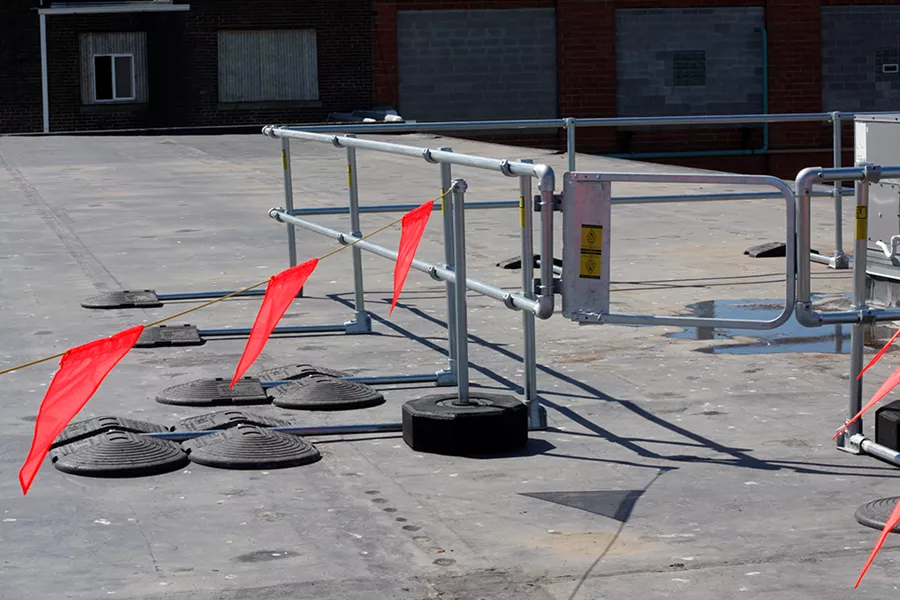
You are visiting the Canada Kee Safety website from United States. Would you like to go to the United States site?

More than 1.5 million people work in the construction industry, and they build everything from critical roads and bridges to spectacular, gorgeous structures. Yet, the statistics for worksite safety are not pretty.
Implementing safety solutions, especially fall protection, for the construction workforce is critical for organizations to prevent accidents and comply with regulations. These include both “active” and “passive” or “collective” fall protection systems, such as lifelines and anchorages, guardrail systems, and platforms and walkways.

Active fall protection involves the worker directly, such as personal fall protection equipment (PFPE), notably lifeline and anchor systems. Workers need to be expertly trained in using and inspecting their equipment. Canadian Occupational Health & Safety regulations specify the requirements and components of an active personal fall protection system where there is a risk of an injury due to a fall.
Engineered horizontal lifelines provide continuous fall protection for multiple users with unhindered access along the length of the lifeline. They feature galvanized and stainless steel components for strength, durability, and corrosion resistance. Regulatory-compliant anchorages are the backbone of lifeline systems. According to federal, provincial, and territorial regulations, permanent and mobile anchors must have an ultimate load capacity in any direction required to resist a fall of at least 22 kN (5000 lbs).

Rigid post anchors can be integrated with horizontal lifelines and tieback lifelines, and to support suspended platforms. They feature high-strength welds and are galvanized to ASTM A123. These permanent anchorages can be installed on all standard surfaces (e.g., steel, concrete, timber) on flat or low-slope roofs, BUR membrane systems, single-ply membranes, modified bitumen, green roofs, and metal roofs.
Mobile roof anchors for flat or low-sloped roofs feature a central pedestal supported by high-friction, rubber-coated base weights for use in wet or dry conditions. Attachment options are available for horizontal and other types of lifeline systems

Passive or collective fall protection is not unsafe. It is the preferred fall protection method because it safeguards multiple workers without requiring specialized equipment or training. Guardrail systems are a prime example. Modular safety railing systems constructed of anodized aluminum or galvanized steel are strong, durable, and corrosion-resistant. They are installed on-site without welding or drilling.
Freestanding roof edge protection systems feature counterweight recycled PVC bases that do not penetrate the roof. Its modular design adapts to virtually any roof configuration.
Modular safety railings suit site-specific requirements, such as creating barriers around hazardous areas and providing fall protection for elevated platforms and other work-at-height areas. Galvanized steel railings are an industry standard. Aluminum safety railings are ideal for applications requiring a lighter weight or the capability to withstand harsher environmental conditions.
Demarcation warning lines provide another form of collective fall protection for temporary set-up, indicating safe work or navigation areas. They feature non-penetrating PVC bases, galvanized steel uprights, sturdy cables with stainless steel shackles, and high-visibility triangular safety flags.

On rooftops, a warning line can only be used within 6 feet (1.8 metres) of the roof edge if an active (lifeline) or passive (guardrail) fall protection system is also in place. An active or passive system should be in place for work between 6 and 15 feet (1.8 to 4.6 metres), but a “designated area” (such as a warning line) can be used if the work is infrequent (performed no more than once per month) or temporary (taking less than two hours). Although other fall protection measures should be in place beyond 15 feet (4.6 metres), warning lines can be used if access within 15 feet (4.6 meters) is prohibited.

Navigating rooftops and elevated areas can pose significant risks due to uneven surfaces, obstacles, and slippery conditions. Rooftop walkway systems offer a safe, anti-slip, level walking surface that reduces the risk of a slip and fall. Featuring self-draining nylon treads set in sturdy aluminum or galvanized steel frames, walkways are adaptable to various roof types and pitches. A stepover platform with these same treads enables workers to avoid obstructions such as cables and piping.
Work access platforms allow workers to reach elevated heights to work on large equipment or at higher levels. They incorporate roof walkway treads in modular pipe-fitted frames to build stairs and platform decks. Compliant guardrails provide additional fall protection. Types of work platforms include:
Fall protection solutions in the construction industry are essential for safeguarding workers and maintaining site compliance. Lifelines, anchorages, guardrails, warning lines, walkways, and work platforms provide several options to address hazards on worksites, reduce the risk of accidents and injuries, and meet regulatory requirements.
Falls, slips, and trips are one of the leading causes of injuries and deaths on construction sites. But there are key strategies companies can implement to reduce the risk of these types of incidents.